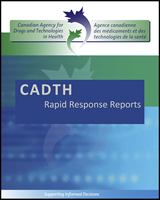Context and Policy Issues
Uterine fibroids are the most common pelvic tumours and the most common benign tumours in women. Usually diagnosed late in a woman’s reproductive life, fibroids are present in up to 40% of women older than 40 years. Fibroid-related symptoms are often divided into menstrual symptoms, such as heavy bleeding, or bulk-related symptoms that result from the enlargement of the uterus. Common symptoms include abnormal uterine bleeding, pelvic pressure and pain, infertility, recurrent pregnancy loss, and decreased quality of life. Medications or surgical interventions may be needed to treat fibroids. Hysterectomy is a definitive solution for many women; however, alternatives that preserve fertility and avoid invasive surgery do exist. The less-invasive uterine-preserving alternatives include myomectomy, uterine artery embolization or occlusion (UAE or UAO), myolysis, and endometrial ablation. Each carries its own safety and effectiveness profile, and the treatment of fibroids must be individualized depending on such factors as symptoms, size and location of fibroids, age, desire for future pregnancy or preservation of the uterus, the availability of therapy, physician experience, and patient preference.
To help guide decisions about the treatment of fibroids, this study systematically reviews the clinical and cost-effectiveness of interventions for symptomatic uterine fibroids that preserve the uterus and are available in Canada, compared with each other or with hysterectomy. Medications have been excluded from this comparison, but do provide an alternative option for short-term therapy.
Research Questions
What is the clinical effectiveness and safety of uterine-preserving interventions for the treatment of symptomatic uterine fibroids, compared with each other or with conventional treatment (hysterectomy)?
What is the cost-effectiveness of uterine-preserving interventions for the treatment of symptomatic uterine fibroids, compared with each other or with conventional treatment (hysterectomy)?
Methods
A peer-reviewed literature search was conducted using the following bibliographic databases: MEDLINE, PubMed, Embase, The Cochrane Library, and the University of York Centre for Reviews and Dissemination (CRD) databases. Grey literature was also searched. The search for health technology assessments, systematic reviews, meta-analyses, and guidelines was limited to documents published since January 1, 2005, while the search for randomized controlled trials (RCTs), controlled clinical trials, cohort studies, and economic studies was not limited by publication year. Regular alerts were established to update all searches until project completion. Predefined eligibility criteria included RCTs, non-randomized studies, and economic evaluations assessing the clinical, cost-effectiveness and safety of uterine-preserving interventions in women with symptomatic uterine fibroids. The interventions of interest included myomectomy, myolysis, UAE, UAO, or endometrial ablation. They were compared with each other or with hysterectomy.
Two reviewers independently selected studies. A data extraction form for the clinical effectiveness review was designed a priori to document and tabulate verified by the second reviewer for accuracy and completeness. The Downs and Black checklist and the Drummond checklist were used to assess the quality of the included clinical studies and economic evaluations, respectively. Any disagreements were resolved through discussion until consensus was reached. Meta-analyses and subgroup analyses were not possible. A narrative synthesis of results of included studies was conducted.
Summary of Findings
Ten RCTs and 16 non-randomized studies were included for the clinical review. The uterine-preserving interventions examined were myomectomy, UAE, UAO, magnetic resonance-guided focused ultrasound (MRgFU), and radiofrequency volumetric thermal ablation (RFVTA). In general, the quality of these studies was low due to small sample sizes and imbalanced baseline patient characteristics between groups, particularly in non-randomized controlled trials. Inconsistent results were observed across the included studies. In addition, the amount of available evidence is limited, and some of the recruited patients may not be suitable candidates for a particular treatment, which limits the applicability of the evidence across treatments.
In summary:
UAE, myomectomy, UAO, RFVTA, and MRgFU reduced fibroid-related symptoms and enhanced patient quality of life from baseline.
UAE was superior to myomectomy in reducing abnormal uterine bleeding. Compared with myomectomy and hysterectomy, UAE had a lower risk of peri-procedural complications, shorter hospital stay, and higher patient satisfaction. However, it was associated with a higher risk of re-intervention compared with UAO.
Myomectomy was superior to UAE in improving bulk symptoms. It also had better pregnancy outcomes, based on limited clinical evidence.
UAO was associated with a lower risk of complications compared with UAE.
RFVTA had a lower risk of peri-procedural complications, had shorter hospital stay, and was associated with more re-interventions in the future, compared with myomectomy.
MRgFU was associated with fewer complications but more re-interventions, compared with UAE and hysterectomy.
In the economic review, the cost-effectiveness of UAE, MRgFU, myomectomy, hysterectomy, and pharmacotherapy was examined in seven economic evaluations performed in North America (one in Canada) and Europe. None of the identified economic evaluations considered all treatments in a single analysis. Findings from the Canadian economic evaluation suggest that when 35% of patients were assumed eligible for treatment with MRgFU, UAE was more cost-effective than MRgFU, hysterectomy, and myomectomy at commonly accepted willingness-to-pay thresholds. Compared with hysterectomy, UAE had an incremental cost-effectiveness ratio of $46,480 per quality-adjusted life-year gained.
Conclusions and Implications for Decision- or Policy-Making
Evidence from 26 studies on the clinical effectiveness and safety of uterine-preserving interventions to manage symptomatic uterine fibroids was reviewed. Study findings suggested that UAE, RFVTA, and MRgFU were associated with fewer procedure-related complications, shorter hospital stay, and higher patient satisfaction, compared with hysterectomy, in short-term follow-up; however, patients treated with hysterectomy reported better health-related quality of life. In the long term, uterine-preserving interventions are linked to more re-interventions. Patients treated with myomectomy had better reproductive outcomes than UAE, based on limited clinical evidence.
While results from the economic literature vary, given differences in settings, populations, and perspectives, there is one Canadian economic evaluation that suggests that when 35% of patients are assumed eligible for treatment with MRgFU, UAE is more cost-effective than MRgFU, hysterectomy, and myomectomy.

